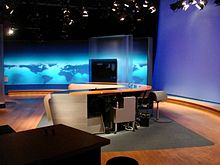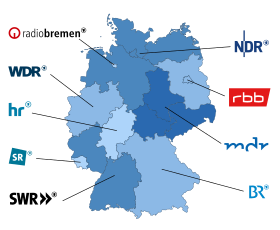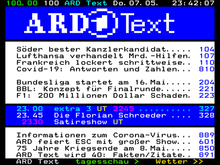Television in Germany
| Part ofa serieson the |
| Culture of Germany |
|---|
 |
| Festivals |
| Music |
Television in Germanybegan inBerlinon 22 March 1935, broadcasting for 90 minutes three times a week. It was home to the first regular television service in the world,[1]namedFernsehsender Paul Nipkow.
In 2000, the German television market had approximately 36.5 million television households, making it the largest television market inEurope.[2]Nowadays, 95% of German households have at least one television receiver.[3]All the main German TV channels arefree-to-air.
History[edit]

In 1948 the British occupation forces allowedNWDRto broadcast television programmes for the British zone. Other regional networks also started to launch television in their own areas. Meanwhile, the GDR was launching its own television service,Deutscher Fernsehfunk(DFF), based on theSovietmodel.
A regular schedule began through the cooperation of allARDmembers in 1954. Basic principles in the central areas of entertainment, information and enlightenment were established and television plays developed as the medium's own specific art form. Improvements in technology and programming, as well as reduced prices, led to a steady increase in licence holders, and the number of licenses passed the 1-million mark in October 1957.
On 1 April 1963, the long-promised second TV network, theZweites Deutsches Fernsehen(Second German Television) started. Unlike ARD, which was regionalized and had its roots in radio, ZDF was a centrally organized channel devoted solely to television. On 25 August 1967, at 9:30 a.m. on both ARD and ZDF, vice chancellorWilly Brandtstarted the era of colour TV inWest Germanyby pressing a symbolic launch button at the International Radio and TV Fair in West Berlin.
East Germanystarted DFF2 in 1969, and introduced colour programming on both channels. In 1972, the DFF was renamed, dropping the pretense of being an all-Germany service and becoming Fernsehen der DDR (GDR Television) or DDR-FS. Its two channels became known as DDR1 and DDR2.
The first two privately financed TV networks,RTL plus(short for Radio Television Luxemburg) andSAT 1,started their programming in West Germany in 1984. (Previously RTL broadcast fromLuxembourgbut was only received in parts of Southwestern Germany).
Afterreunification,the TV stations of theGerman Democratic Republicwere dissolved and the remnants were used to found new regional networks, e.g. theMitteldeutscher Rundfunk(Central German Broadcasting), as part of the ARD. In addition, more private TV stations opened, becoming available through cable, satellite and in some cases, over the airwaves.
Market[edit]
Today, with almost 40 million TV households, 365 TV channels licensed in Germany and a total market volume of €9,615 million in 2008, Germany represents one of the biggest and most diversified TV markets in the world. The strongest revenue segment in Germany is public funding (€4,430 million in 2008), followed by advertising (€4,035 million) and subscription (1,150 € million).[4]This dominant market position of public and advertisement funded free TV channels in Germany explains why the German pay TV segment is significantly underperforming in an international comparison.[5]
In terms of total TV viewing market share Germany's market leaders in 2023 were again the two biggestpublic-servicechannels (ZDF with 14.6% and Das Erste with 11.9%) and the two leading commercial channels (RTL with 7.9% and Sat.1 with 4.7%).[6]The leading pay TV provider wasSky Deutschland(see below). The biggest teleshopping providers in Germany are QVC and HSE24.
With 18.1 million TV households satellite is the dominant TV infrastructure in Germany, followed by cable (17.9 million TV households) and terrestrial (3.8 million TV households).[7]In a 2010 survey half of German television viewers said they often found nothing to watch on television.[8]
TheGermanophonesphere is the largest market fordubbingin Europe. Foreign TV shows and other formats are often dubbed into German, whilesubtitledformats with the original language are also becoming more popular.[9]
Channels[edit]

The channels with the largest viewing share in 2023 are:[6]
| Position | Channel | Owner | Share of total viewing (%) in 2023 |
Share of total viewing (%) in 2011[10] |
Comparison 2023/2011 |
|---|---|---|---|---|---|
| 1 | ZDF | ZDF | 14.6 | 12.1 | |
| 2 | Das Erste | ARD | 11.9 | 12.4 | |
| 3 | RTL | RTL Group | 7.9 | 14.1 | |
| 4 | Sat.1 | ProSiebenSat.1 Media | 4.7 | 10.1 | |
| Vox | RTL Group | 4.7 | 5.6 | ||
| 5 | Kabel Eins | ProSiebenSat.1 Media | 3.2 | 4.1 | |
| 6 | ProSieben | ProSiebenSat.1 Media | 3.0 | 6.2 | |
| 7 | ZDFneo | ZDF | 2.6 | 0.4 | |
| NDR Fernsehen | NDR/RB | 2.6 | 2.5 |
The combined share of ARD's so called Third Programmes (regional broadcastersWDR,NDR,SWR,etc.) was 13.8% in 2023[11]
Subscription channels[edit]
Germany's sole subscription channel Premiere had its heyday around the millennium. Premiere offered telecasts of the German football league – theBundesliga,but they lost the broadcasting rights in 2006 to a newly formed competitor –Arena.Premiere was the brainchild of the former television czar,Leo Kirch.He went into insolvency after a decade of losing viewers from his subscription channel, DF1 (Digital TV 1). The company regained some ground with its new managerGeorg Kofler.[citation needed]
In 2005, several German cable companies created a new challenger to Premiere - ARENA. The participating companies areiesy(Hesse) andish (TV)(North Rhine-Westphalia) through their combined partnership called "Unity Media".Arena, a rather small company, wanted to buy the pay-TV rights to the German Bundesliga and won by a decision of the marketing directorate of theDFL.The rights to broadcast the Bundesliga is regarded as lucrative in the German television market, so previous rights holders Premiere suffered a wounding blow to their business model. Arena held the rights from 2006 to 2008. Further negotiations were due in 2008 for the broadcasting of theBundesliga.
Public broadcasters[edit]

As stated above, the ARD was the first German broadcasting station. It has a federally orientated structure. At present, nine regional public broadcasters cooperate to produce programs for the TV network known asDas Erste(The First):
- Norddeutscher Rundfunk–North German Broadcasting–Hamburg,Lower Saxony,Schleswig-HolsteinandMecklenburg-Vorpommern
- Radio Bremen– also a television broadcaster –Bremen
- Rundfunk Berlin-Brandenburg–Berlin-Brandenburg Broadcasting–BerlinandBrandenburg
- Mitteldeutscher Rundfunk–Central German Broadcasting–Saxony,Saxony-AnhaltandThuringia
- Westdeutscher Rundfunk–West German Broadcasting–North Rhine-Westphalia
- Hessischer Rundfunk–Hessian Broadcasting–Hesse
- Südwestrundfunk–South Western Broadcasting–Baden-WürttembergandRhineland-Palatinate
- Saarländischer Rundfunk–Saarland Broadcasting–Saarland
- Bayerischer Rundfunk–Bavarian Broadcasting–Bavaria
Seven of these broadcasters run their own regional TV programs (The Third), most of them use several frequencies and show local opt-outs. While multi-state-broadcastersNDR,RBB,MDRandSWRhave state versions (e.g. RBB Berlin, MDR Sachsen, NDR Hamburg and SWR Baden-Württemberg),BRandWDRhave regional opt-outs below state level (BR: North and South, WDR: 11 versions). Two small regions,Bremen(RB) and theSaarland(SR), have their own broadcasting stations, mainly for historical reasons. They only contribute to the national TV channelDas Ersteand produce a state opt-out for their neighbour broadcaster (SR Fernsehenon SWR,Radio Bremen TVon NDR).
Teletext[edit]

Germany has run a regularTeletextservice (often called Videotext) since 1 June 1980 on the public broadcasting channels. Almost all German TV stations have teletext.[12][13]Even with the advent of digital television, teletext is still widely used.[14]
Teletext pages are selected via a three-digit number, ranging from 100 to 899. While every station is free to organize their teletext pages in any way, most adhere to the following de facto standard:
- 100 Main page
- 110 News
- 120 News / Weather
- 200 Sports / Soccer
- 300 TV schedule
- 333 On air now
- 600 Advertising, chats, phone sex (commercial channels only)
The teletext system is also used to transmit subtitles on a special, transparent page (usually 149, 150 or 777), so that both text and the normal picture are visible. With the advent of digital television however, a few stations discarded teletext subtitles and are now using the subtitles feature of theDigital Video Broadcasting(DVB) system.
Reception[edit]
This section needs to beupdated.(October 2021) |
| Technology | Total households | Relative households |
|---|---|---|
| Satellite | 17,779,000 | 46.1% |
| Cable (digital) | 11,229,000 | 29.1% |
| Cable (analogue) | 6,630,000 | 9.9% |
| DVB-T | 3,865,000 | 10.0% |
| DSL-TV | 1,899,000 | 4.9% |
| All | 38,557,000 | 100% |
Satellite[edit]
Digital satellite television has been officially available in Germany since 1996. Prior to May 2012, most of the 30+ TV stations broadcast theirsatellitesignal using both analogue and digital (DVB-S); however, all analogue satellite broadcasts ceased on 30 April 2012.
There is currently a single pay TV satellite operator in Germany -Sky Deutschland.Prior to being known as Sky, the service was named Premiere;[15]it (along with its former ownerLeo Kirch) got into serious financial trouble due to its early and proprietary usage of encryption (Betacrypt, D-box). Subsequently, Premiere was bought byNews Corporationand renamed Sky, in keeping with their satellite services elsewhere in Europe (Sky (UK and Ireland)andSky Italia).
- HDTV via satellite
In late 2004 German channel groupProSiebenshowed aBBCdocumentary and a self-produced TV movie in1080iviaMPEG-2DVB-S,followed by the Hollywood filmsSpider-ManandMen in Black IIin March 2005. These were intended to be a test for future commercial HD services.
Regularfree to airbroadcast of the HD versions ofProSiebenandSat.1began on 26 October 2005. Unlike the test broadcasts,DVB-S2andMPEG-4 AVCwere used. Both ProSieben HD and Sat.1 HD ceased their unencrypted broadcasts in 2008; encrypted HD broadcasting of both channels resumed under theHD+brand (which also included other commercial channels; see below) in January 2010.
Premiere, after several delays, started broadcasting three HD channels — one each dedicated tofilms,sportsanddocumentaries— in November 2005, although there were virtually no suitable, certified receivers available on the market. The content was also sparse and thus often repeated. Sky (formerly Premiere) reuses its proprietarydigital rights managementsystem embedded into its content scrambling system (Nagravision) from SD broadcasts to block analogue output of the movie channel from the receivingset-top boxaltogether, only allowingHDCP-secured transmissions; the other channels are less restricted.
On 1 November 2009 the premiumHD+service launched with two channels, RTL HD and Vox HD, with Sat.1 HD, ProSieben HD andKabel einsHD joining the service in January 2010. DSF HD (now called Sport1 HD) began test broadcasts in August 2010 and launched fully on HD+ on 1 November 2010, followed by Sixx HD and RTL2 HD on 1 December 2010. In June 2011, Comedy Central HD, Nickelodeon HD and N24 HD joined service, bringing the number of channels offered to 11. In April 2011, HD+ became available to Sky Deutschland subscribers without the need for an HD+CAMand viewing card (although an additional subscription is still required).
Currently (as of May 2012) all satellite HDTV channels are broadcast using theh.264codec. As of July 2014, most material is upscaled SD content.
- Free-to-air HDTV via satellite
Prior to 30 April 2012 there were eight free-to-air HDTV channels originating in Germany broadcast via satellite: Das Erste HD, ZDF HD, Arte HD, Anixe HD,[16]EinsFestival HD,[17]sonnenklar.TVHD, QVC HD and HSE24 HD.[18]After 30 April 2012, when all analogue satellite broadcasts ceased, ten additional FTA HD channels became available (all of which arepublic servicechannels):PhoenixHD,NDRHD,WDRHD,BRHD,SWRHD,ZDFneoHD,ZDFinfoHD,ZDFkulturHD,3satHD andKiKaHD.[19][20] From December 2013 on all PSB channels exceptARD- Alpha,SR FernsehenandRadio Bremen TVare available in HD.
Cable[edit]
DVB-C transmission started in 2004 withpay TVPremiere and digital versions of the analogue channels.
The rather late changeover to DVB was caused both by the long process of selling the infrastructure of former monopolistDeutsche Telekomto others and the fact that the cable network ends at the curb or property, with the in-house cable in large apartment buildings being operated by a different company. Due to this, the new owners of Deutsche Telekom's cable network were in many cases not able to offer new products directly to the viewer.
By 2006, there were three major cable operators, Unity Media inHesse,North Rhine-WestphaliaandBaden-Württembergand by far the largest,Kabel Deutschlandin the other 13 states. Today, all companies offer about 200 TV channels by DVB-C, which includes some 70 channels at no extra charge as well as a number ofpay-per-viewoffers and subscription-based packages (like the HD-broadcasts of privately owned channels, comparable to HD+ on satellite). In addition to that pay TV broadcasterSky Deutschlandis also available.
In some very large apartment complexes a number of local and national companies operate an in-house cable network which is fed solely by its own satellite antenna on the building, not the local cable operator. The satellite channels are either transcoded into analogue transmission, receivable by any TV set without extra equipment, or into DVB-C.
As of 2014, still 17.2% of Germany transmits television with analogue cable signals, compared to 29.1% of digital cable; this similar to the situation in theNetherlands,SwedenandBelgium,where analogue cable is also still widely used.[21]
Terrestrial[edit]
Terrestrial reception had lost most of its users by the 1990s[citation needed]due to extensive cable and satellite coverage. In a two step process analogue terrestrial TV broadcasting in the states ofBerlinandBrandenburgwas switched off in 2003 and replaced byDVB-T,in 2005, about two-thirds of Germany's states began to replace analogue transmission. By 2006, all metropolitan and most rural areas had moved to digital transmission. Today, only foreign army bases and some local TV stations still broadcast on analogue.
While the public broadcastersARDandZDFtransmit throughout Germany, commercial stations often are only available within metropolitan areas, so the number of available channels varies between about 10 and 30. All DVB-T1 channels werefree-to-airand the broadcasters rented transmission services directly from a transmitter operator, usuallyMedia Broadcast.ARD stations also use their own transmitters.
In June 2016, a gradual switch-over fromDVB-TwithMPEG-2encoding toDVB-T2withHEVCencoding has commenced. The first phase included one new multiplex broadcasting six channels in selected urban areas, in addition to the old DVB-T standard.[22]The DVB-T2 channels are broadcasting in 1080p50.[23]The commercial channels are encrypted and part of the "Freenet TV" -Package.[24]The final switch-over to DVB-T2 occurred in steps, starting with major metropolitan areas who switched on 29 March 2017. The last transmitter is planned to switch in 2019.[25]
Series[edit]
Almost all fictional programs on German television are regular TV series. While the public broadcaster(s) predominantly own(s) the productions that are broadcast, the private stations/networks often put on series licensed from abroad, mainly the United States. Peaking in the 1990s, the private channels had aired self-produced series such asDer Clown(1996–2000),Alarm für Cobra 11 – Die Autobahnpolizei(Alarm for Cobra 11 - The Motorway Police) (since 1996),The Sentinel(1994–1996),Alpha Team - The Lifesaver in OP(1996–2005) orWolff's Turf(mainly from 1992 to 2006) with great success. Since the late 2000s, the amount of original series on the private broadcasters has markedly declined.
The highest-rated series is the crime dramaTatort,which airs almost every Sunday on public broadcasterARD.It has run since 1970 and has featured several casts, that are not related to each other.
See also[edit]
- Telecommunications in Germany
- List of television stations in Germany
- List of German language television channels
- List of German television series
- German television comedy
- International Television Expert Group
- Media of Germany
- Dubbing (filmmaking) § Germany, Austria and Switzerland
References[edit]
- ^"22.3.1935: Erstes Fernsehprogramm der Welt".Deutsche Welle.Retrieved9 March2024.
- ^"Digital Single Market"(PDF).Digital Single Market.European Commission.
- ^"Staat & Gesellschaft - Ausstattung mit Gebrauchsgütern - Ausstattung privater Haushalte mit Unterhaltungselektronik - Deutschland - Statistisches Bundesamt (Destatis)".destatis.de.Retrieved2016-11-18.
- ^German TV Market Report 2009International Television Expert Group
- ^Global TV Market Report 2009International Television Expert Group
- ^ab"RTL legt zu, ProSieben größter Verlierer, Kabel Eins klar im Plus".dwdl.de.Retrieved2024-01-03.
- ^"Satellitenfernsehen in Deutschland".kabelfernsehen-kabelanschluss.de.Retrieved2016-04-05.
- ^Operators need an EPG+ strategy for content discoveryArchived2011-11-19 at theWayback Machine
- ^"Hollywood dubbing: The German Bruce Willis and other invisible stars".BBC. 21 February 2013.Retrieved14 April2015.
- ^"AGF - Marktanteile".agf.de.Retrieved2015-04-10.
- ^"So lief 2023 für die Spartensender".dwdl.de.Retrieved2024-01-03.
- ^"Teletext im Ersten".Das Erste.Retrieved10 April2017.
- ^"Teletext Viewer".SevenOne Media.Retrieved10 April2017.
- ^"Teletext: Nicht totzukriegen".3 August 2018.
- ^"Premiere soll künftig Sky Deutschland heißen".spiegel-online.de. 13 February 2010.
- ^"Sat.1 HD and ProSieben HD go offline until 2010 in Germany - Engadget HD".Engadget HD.16 February 2008.
- ^"HDTV in Einsfestival | Einsfestival".EinsFestival(in German). ARD. Archived fromthe originalon 2012-05-09.Retrieved8 April2012.
- ^"Astra: Sonnenklar TV ab September in HD frei empfangbar - DIGITALFERNSEHEN.de"[Astra: Sonnenklar TV available in HD for free from September - DIGITALFERNSEHEN.de].Digitalfernsehen.de(in German). 19 August 2011.Retrieved8 April2012.
- ^"ZDFneo, 3sat, BR, NDR, SWR, WDR, Phoenix, KiKa starten HD Kanäle"[ZDFneo, 3sat, BR, NDR, SWR, WDR, Phoenix, KiKa launch HD channels].kabel-internet-telefon.de(in German). 13 March 2012.Retrieved8 April2012.
- ^"HDTV: Neue HD-Kanäle von ARD und ZDF ab 30. April 2012"[HDTV: New HD channels from ARD and ZDF after 30 April 2012].T-online.de(in German). 20 January 2012.Retrieved8 April2012.
- ^http:// die-medienanstalten.de/fileadmin/Download/Publikationen/Digitalisierungsbericht/2014/Digitalisierungsbericht_2014_Daten_und_Fakten.pdfDigitalisierungsbericht 2014 - Daten und Fakten
- ^"List of sites for the DVB-T2 HD preview mux"(PDF).
- ^"DVB-T2 HD: ARD vorerst nur hochskaliertes Full HD".Retrieved2016-10-24.
- ^Weidner, Markus."DVB-T2: Private Programme werden als Freenet-TV vermarktet".Retrieved2016-10-24.
- ^"DVB-T2 HD - offizielles Informationsportal".DVB-T2 HD - offizielles Informationsportal.Retrieved2016-10-24.
